It doesn't take long to spot that the locals like a bit of grease with their dinners (and lunches and breakfasts). 75% of dishes are stir fried and stews/ braises / soups etc usually start with a fried base. Even your 'healthy' steamed stuff is often dressed with an oily sauce.
So, what are they using for all these oleaginous offerings?
The number one fat, and the most traditional, is simple lard (pig fat – S:猪油; T: 豬油 - zhū yóu)
Your canny Chinese house spouse will buy a nice fatty piece of pork, render out the fat and use it to stir fry the vegetables, while cooking the meat separately.
I always laugh when I read articles from Chinese food lovers in London or San Francisco rattling on about the healthy way the Chinese steam their vegetables in their bamboos baskets. No they don't! I've never, ever met anyone who used a bamboo basket in a Chinese domestic kitchen. I've only once ever seen them on sale. They are only used in dim sum restaurants or roadside breakfast dumpling shops.
I don't mean that local home cooks don't steam stuff. They do – steamed fish, steamed eggs. But I've rarely seen steamed vegetables – and those only in a few restaurants (usually Cantonese). Veggies are usually cooked in lard. Something for vegetarians to think about when eating out.
I have seen lard on sale in supermarkets, but most home cooks just render it themselves.
To make the lard, the cook trims the fat from the meat and cuts it into roughly even sized cubes. These are placed in a dry wok, initially at a low heat until the first oil is rendered. Then it is just a matter of giving it an occasional stir and draining off the rendered fat from time to time. When the fatty lumps start to brown they are discarded (some friends eat them!)
The newly rendered fat looks a bit unappealing, but after a while in the fridge any impurities tend to sink to the bottom and the fat turns white. The more fastidious could strain it through a fine sieve. The locals wouldn't bother.
.jpg.164f82c7c6bf8a94f11afb8cda6ef8dc.jpg)
Trimmed pork fat
.jpg.0f2104eaafe342cab6272ad3439184bd.jpg)
Chopped pig fat
.jpg.35782b33701e98c993ec0b44b950f513.jpg)
Pig fat in wok
.jpg.05736b631c838a16b8cddba1acb487fa.jpg)
The lard beginning to render out
.jpg.6c497d2471f20d0006ae0a671481145e.jpg)
The cubes on the right have given up all their oil and will be discarded (or eaten).
.jpg.82eae3aea22d6c97d65a4fce4cd7044a.jpg)
Newly rendered lard, still hot.
Beef fat (dripping) is also used in the traditional Sichuan hotpot stock.
It's not so much a Chinese habit, but I regularly do the same with duck fat. But I'm addicted to potatoes cooked in duck fat! The fat from a couple of duck legs renders down to a lot of beautiful fat. It keeps almost forever – at least it would if didn't keep eating it!
Duck fat – chilled
For other cooking, the oil of choice round here is peanut / groundnut oil 花生油 - huā shēng yóu. 90% of the oil in every Liuzhou supermarket is peanut oil (although other parts of China have different preferences).
You can even buy it directly from oil producers in back streets who grind the nuts themselves. I wouldn't go near them. You don't want 'gutter oil' – S: 地沟油; T: 地溝油 - dì gōu yóu. This is cooking oil that has been used and discarded, illegally reprocessed and sold back to restaurants.

Peanut Oil – 花生油 - huā shēng yóu
Other easily findable oils include:
Corn / maize oil – 玉米油 - yù mǐ yóu
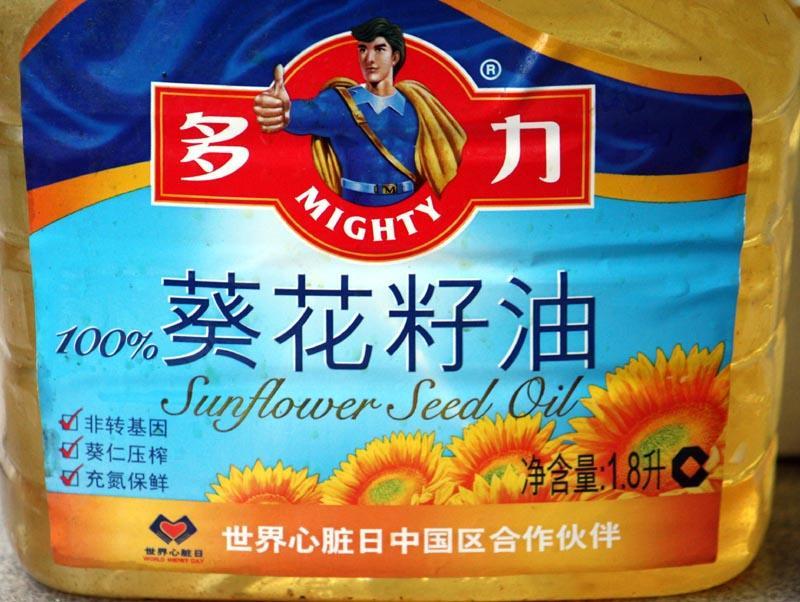
Sunflower oil – 葵花(籽)油 - kuí huā (zǐ) yóu
Soybean oil – 豆油 - dòu yóu
My default oil is is rice bran oil – 米糠油 (mǐ kāng yóu) or 稻米油 (dào mǐ yóu).
Rice Bran Oil - dào mǐ yóu
All these oils are valued for their supposed neutral taste and high smoke point which makes them ideal for stir frying. I say 'supposed' because I can always taste the peanuts in peanut oil. I hate eggs fried in peanut oil.
Relatively common is 食用调味油 (shí yòng tiáo wèi yóu) literally 'food grade dressing oil'. This is often labelled in English as Blended Oil, Vegetable Oil or Salad Oil. I never buy it. I prefer to know what I am eating. It tends to be the cheapest oil and is largely based on rapeseed oil (canola) but basically contains whatever was cheapest or had to be used up that week.
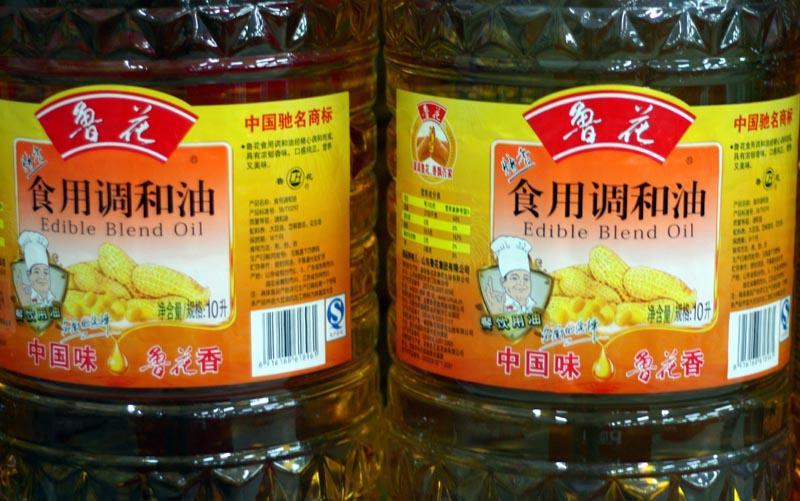
Blended Vegetable Oil
I have deliberately not given prices for any of these oils. Prices vary dramatically, even within one store. I suppose the price reflects the quality – first pressing vs second pressing etc – but I wouldn't guarantee it.
Occasionally, you do get specific blends – a common one is sunflower and olive oil – 橄榄葵花油 - gǎn lǎn kuí huā yóu.

Sunflower and Olive Oil (right)
Which brings me to a problem area. On August, 23rd 2005, for the first time ever, I found olive oil (S: 橄榄油; T: 橄欖油 - gǎn lǎn yóu) in Liuzhou. I only know the date because I rushed home with my oil and took a celebratory picture of me holding the bottle. The picture's embedded information includes the date. No. I'm not posting that picture here, but it was this.
Today, olive oil is in every decently sized supermarket and also in some independent places. The problem is no one really knows what it is. I get infuriated when I'm in the supermarket and some 'assistant' wakes up long enough to start recommending different bottles to me. She hasn't a clue and has probably never actually tasted the stuff.
I've never come across any good olive oil in a supermarket. They are industrially produced oils rather than artisan oils. The most common brand in Liuzhou is Olivilà, which sounds suitably Spanish. It is also labelled 'Mediterranean' which means nothing in this context. It's a blended oil and the Spanish sounding brand is actually part of Singapore registered Wilmar International Limited, the world's largest edible oil company. The company has also been named by Newsweek as the world's worst company because of its record of human rights abuses and environmentally damaging practices.

Arawana Logo – 金龙鱼 - jīn lóng yú
In fact, nearly all oils in the supermarket come from this company. The ubiquitous Arawana (above) brand of oils is one of theirs.
Another giant is the Chinese company, 多力油 which uses the English brand name "Mighty". I tend to go more for their oils, although no oil company is perfect.

Mighty Oils – 多力油 - duō lì yóu
Another problem with olive oil here is the pricing. It seems totally random. The supermarket people don't know the difference between 'extra-virgin olive oil', 'pure olive oil' and just 'olive oil', never mind 'stone-ground', 'cold-pressed' or 'first pressing'. They (over-)charge pretty much the same for them all. Plain 'olive oil' should be a lot cheaper than 'extra-virgin' and 'pure' somewhere in-between. Most EV oils are around 100元 for 750ml, but I've seen them go up to 500元 for lower quality oils. Ridiculous.
The only olive oil I buy now is this which I buy online. It's not the greatest in the world, but acceptable.
NOTE: Extra virgin olive oil is not suitable for Chinese (or any other) cookery. It has too low a smoke point and would be scorched in a stir-fry; downright nasty in a deep fry. Keep it for salads. Most of my Chinese friends seem to use it as a skin conditioner!
Other oils for cooking include imported grapeseed oil which has a relatively high smoke point (216 °C), making it suitable for the high temperatures of wok cooking or deep frying. It is a by-product of the wine making industry.
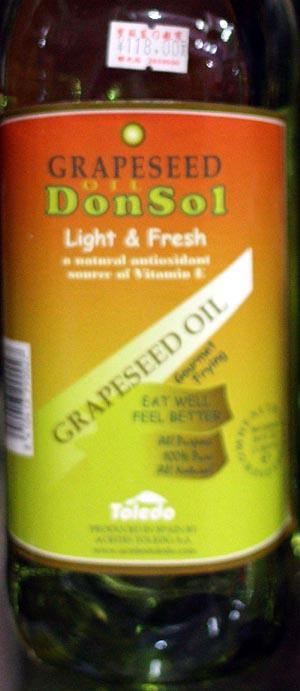
Despite its popularity in western countries, and despite the abundance of rape fields here, rape seed oil or canola is not common in Liuzhou. I see it occasionally in supermarkets but a careful trawl through most of them this week found none. In other parts of China, it's ubiquitous.
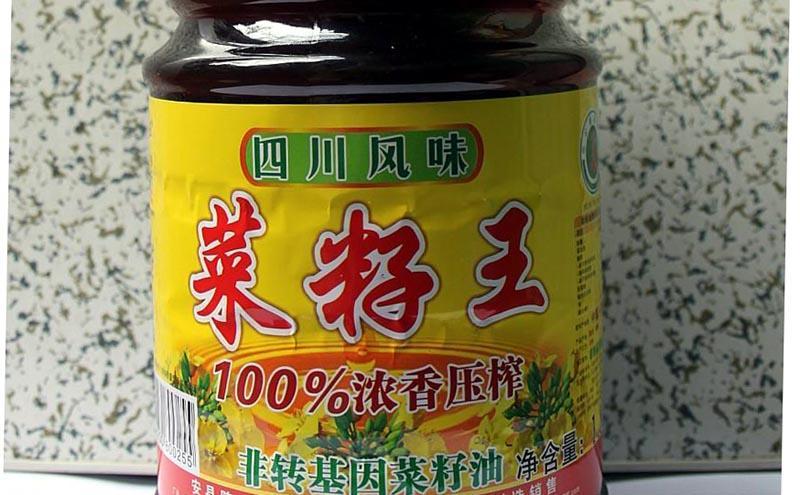
Rapeseed Oil / Canola - 菜籽油 - càI zǐ yóu
Others include camelia oil, widely used in Hunan, but less so here. Known in Chinese as 山茶油 - shān chá yóu, it has a very high smokepoint and is neutral in taste. It is available in Liuzhou supermarkets, but can be pricey.
.jpg.ea00b4a351f93f480f874eeff6d3635d.jpg)
Camellia Oil - 山茶油- shān chá yóu
A relatively recent arrival is avocado oil, but then so are avocados. Again, this is imported and expensive.
Finally, for now, we have perilla oil –紫苏油 - zǐ sū yóu. It too has a high smoke point and a slightly herbal flavour. It is, however, more prized for its supposed health benefits. Perilla oil is a very rich source of the omega-3 fatty acid alpha-linolenic acid (ALA). About 50 to 60% of the oil consists of ALA. It isn't very common in Liuzhou (it's more popular in Korea), but it's around.
Perilla Oil –紫苏油 (zǐ sū yóu)
Next tme, I plan to deal with what I call condiment or finishing oils.


.thumb.jpg.1acf7337eecffb5101f9ef09242dbb19.jpg)
.thumb.jpg.cff266ae7872346831e0b7b8d0b5291c.jpg)
.thumb.jpg.7e587be8d63a30020124bb506d805899.jpg)
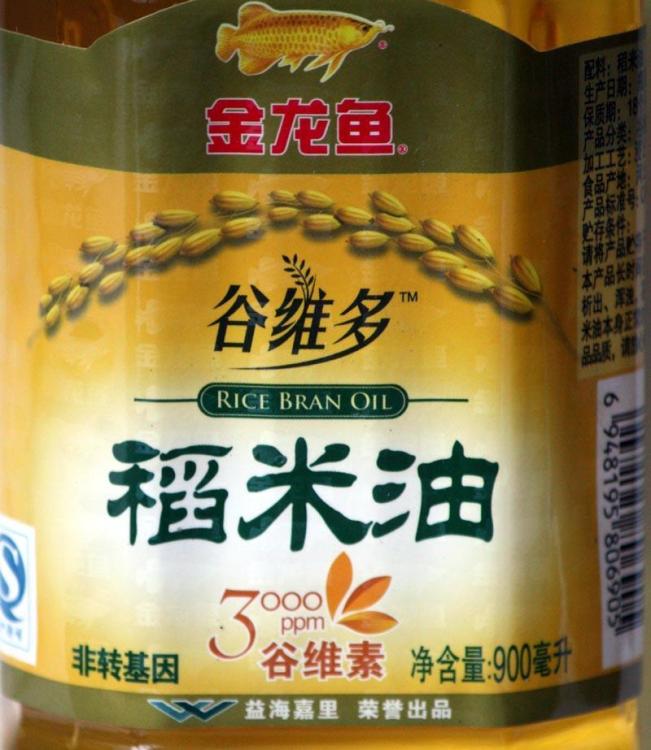

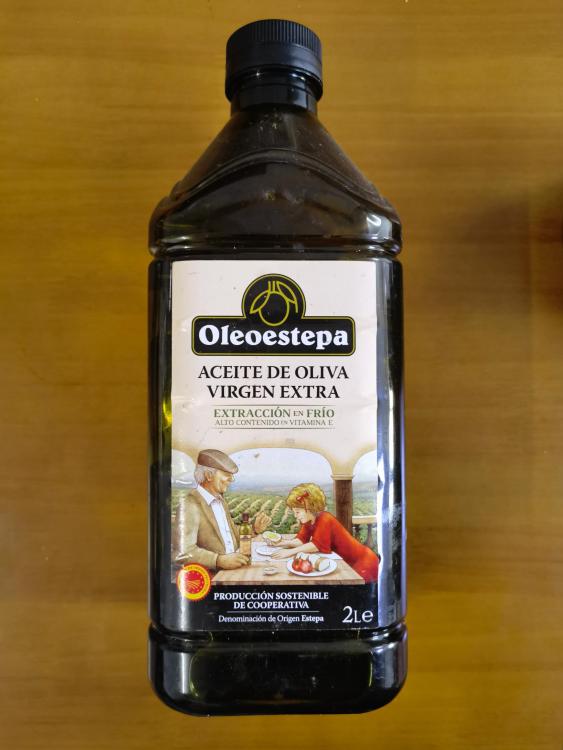

.thumb.jpg.e6e373f10b3d2af801e18b9e490508f7.jpg)